As individuals approach retirement, a key concern often revolves around ensuring a steady income stream to support their lifestyle. The Canada Revenue Agency’s Registered Retirement Income Fund (RRIF) offers a solution, allowing retirees to transform their savings into a consistent income source. However, understanding the intricate web of CRA RRIF withdrawal rules is paramount for a financially secure retirement. This article unravels these rules, providing insights into how they impact your retirement income strategy.
The Essence of RRIFs
A Registered Retirement Income Fund (RRIF) is an integral component of retirement planning in Canada. It’s designed to offer retirees flexibility in managing their retirement savings. An RRIF serves as a vehicle to convert your Registered Retirement Savings Plan (RRSP) or other eligible pension plans into an income stream during your retirement years.
Introduction
While the RRIF provides a structured way to access your retirement savings, it’s important to recognize that it comes with specific withdrawal rules imposed by the Canada Revenue Agency (CRA). These rules dictate the minimum amount you must withdraw from your RRIF each year, ensuring that you don’t deplete your retirement savings prematurely and that taxes are collected on the income generated.
Minimum Withdrawal Requirements
The cornerstone of the CRA RRIF withdrawal rules is the concept of the minimum withdrawal amount. This amount is calculated based on your age and the value of your RRIF at the beginning of the year. The idea is to ensure that your RRIF is gradually depleted over your lifetime, reflecting the original intention of your retirement savings as a long-term income source.
Age-Based Calculations
The minimum withdrawal amount increases as you age, aligning with the rationale that retirees might require larger withdrawals to meet their needs in later years. For instance, if you’re in your early 70s, the minimum withdrawal rate is higher than someone in their 60s. This age-based approach aims to balance the longevity of your savings with your evolving financial needs.
Balancing Act: Tax and Income
The CRA RRIF withdrawal rules are not just about managing your income; they’re also intricately linked with tax considerations. The withdrawals you make from your RRIF are considered taxable income. Therefore, while you’re mandated to withdraw a certain minimum, you also need to account for the potential tax implications of these withdrawals.
Options for Withdrawal
While the CRA sets the minimum withdrawal amount, you can withdraw more than the minimum if your financial situation permits. This could be advantageous if you anticipate higher expenses in a given year or if you want to manage your tax liability strategically. However, it’s important to balance withdrawing enough for your needs and preserving your RRIF’s longevity.
Impact on Retirement Lifestyle
Navigating the CRA RRIF withdrawal rules involves a delicate balance between managing your immediate financial needs and securing your long-term retirement lifestyle. Striking this balance requires careful consideration of other sources of income, future financial goals, and potential health-related expenses.
Understanding Potential Penalties
It’s important to adhere to the withdrawal rules to avoid potential penalties. If you withdraw less than the required minimum, you could face tax penalties on the amount that falls short. Conversely, withdrawing more than the minimum might lead to unnecessary tax burdens if not managed strategically.
Long-Term Financial Planning
The withdrawal rules aren’t isolated from your broader retirement planning strategy. They intersect with factors such as your investment portfolio, other sources of income, and even estate planning. As such, it’s essential to approach RRIF withdrawals as part of a holistic financial plan that aligns with your retirement goals and aspirations.
Seeking Professional Guidance
Given the complexities of the rules and their implications on your financial well-being, seeking advice from financial professionals is highly recommended. Financial advisors can help you navigate the intricacies of RRIF withdrawals, taking into account your unique circumstances, tax implications, and long-term goals.
Conclusion
As you venture into retirement, the CRA RRIF withdrawal rules form a critical piece of the puzzle. They dictate the rhythm of your retirement income, ensuring a balance between present needs and future security. By understanding and strategically managing these rules, you’re not just navigating withdrawals; you’re orchestrating a symphony of financial stability harmonizing with your retirement dreams.
Secure your retirement journey by mastering the art of RRIF withdrawal rules – where financial strategy meets the rhythm of your golden years.
The rules governing RRIF withdrawals are more than regulations; they’re instruments of financial management that resonate throughout your retirement. By delving into the nuances of the withdrawal rules, you’re taking control of your retirement income, aligning it with your lifestyle, and ensuring that your years after work are filled with the comforts and experiences you’ve envisioned. It’s a journey that requires understanding, strategy, and a vision for your desired future.

